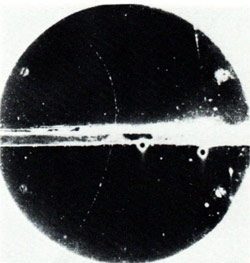Landmarks: The First Antiparticle

APS has put the entire Physical Review archive online, back to 1893. Focus Landmarks feature important papers from the archive.
The 1932 discovery of the positive electron, or positron, was the perfect example of a striking experimental finding following closely on a remarkable theoretical prediction–except that the experimenter wasn’t aware of the theory and came across the new particle by accident. But soon after publishing his results in the Physical Review, he learned of the prediction from others in the field. Coming on the heels of the same year’s identification of the neutron, the discovery of the positron marked the beginning of a decades-long era in which sightings of novel subatomic particles came thick and fast.
In 1930 Carl Anderson of the California Institute of Technology in Pasadena began studying cosmic rays, high energy particles of then-unknown composition that had been found to rain down on the Earth. He used a cloud chamber, in which particle tracks appear as strings of tiny droplets in a supersaturated vapor. When the chamber is set in a magnetic field, each particle’s path curves according to the particle’s charge and energy. Anderson recorded numerous tracks that could have been produced either by negatively charged particles going one way or positively charged particles going the other way.
To distinguish these two possibilities, Anderson placed a 6-millimeter-thick lead plate across the center of his cloud chamber. Any particle passing through the plate would lose energy, making its track curve more sharply on the other side and revealing its direction of motion. In a total of 1300 cloud-chamber photographs, Anderson found 15 tracks that corresponded to positively charged particles. But they could not be protons, he realized, because protons of the right energy to produce the observed track curvature would slow down by collisions after a few millimeters, whereas the tracks he saw were centimeters long.
Anderson briefly announced in Science [1] his discovery of “easily deflectable positives,” following up with a full paper in the Physical Review that carefully analyzed the balance between the particles’ mass and speed and their energy loss along the tracks. Anderson argued that the particles carried one positive unit of charge and had a mass no more than 20 times the electron’s. Jumping to the conclusion that these particles were probably positive electrons, or “positrons,” following the journal editor’s suggestion, he proposed that they were ejected from the nuclei of nearby atoms by cosmic ray impacts.
Anderson knew that Paul Dirac of Cambridge University had worked out a relativistic quantum mechanical equation for the electron. But apparently he didn’t know that in 1931 Dirac had used his theory to predict the existence of a particle identical to the electron except for having the opposite charge. Learning of Anderson’s discovery, Patrick Blackett and Giuseppe Occhialini, also at Cambridge, conducted cloud-chamber experiments in which they saw simultaneous production of positive and negative electron pairs in cosmic ray collisions [2]. They announced their results as direct evidence for Dirac’s predicted antiparticle, a conclusion Anderson quickly agreed with.
Historian Helge Kragh of the University of Aarhus in Denmark suggests that Anderson’s initial interpretation of his results was strongly influenced by the views of his mentor at Caltech, Robert A. Millikan, who had pioneered much cosmic ray research but remained distrustful of highbrow quantum theory. Although the rapid vindication of Dirac’s prediction was an important boost for theory, Anderson always insisted that “the discovery of the positron was wholly accidental” [3].
–David Lindley
David Lindley is a freelance science writer, now retired. His most recent book is The Dream Universe: How Fundamental Physics Lost Its Way (Penguin Random House, 2020).
References
- Carl D. Anderson, Science 76, 238 (1932) [link may require subscription]
- P.M.S. Blackett and G.P.S. Occhialini, Proc. Roy. Soc. A 139, 699 (1933)
- Anderson quoted by A. Pais, Inward Bound, Oxford University Press, p. 352 (1986)


